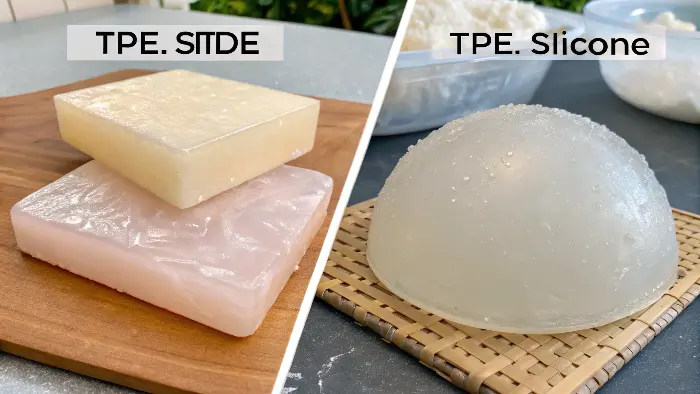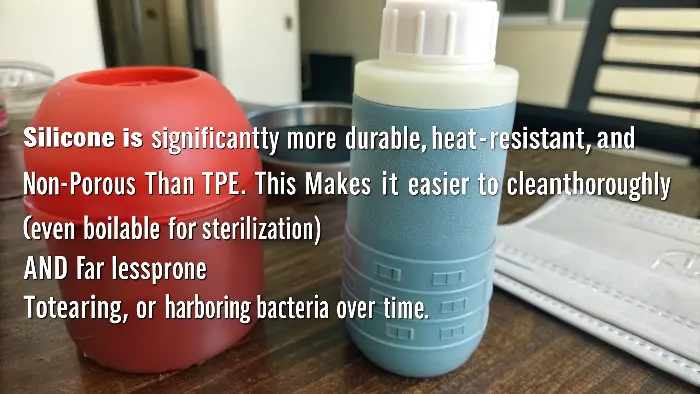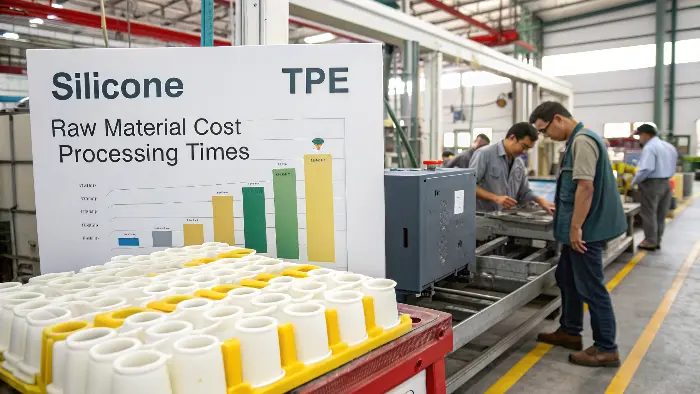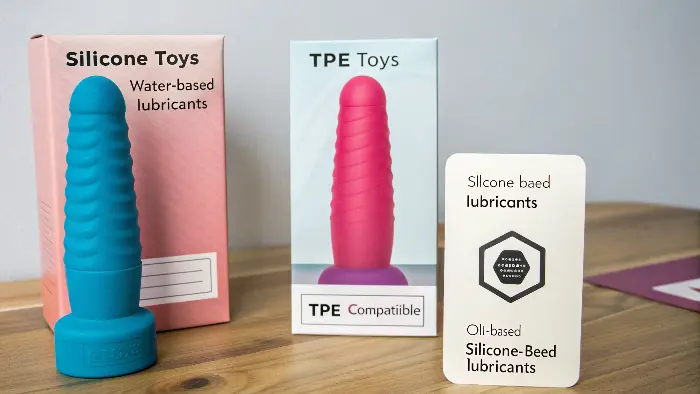Choosing materials for your adult toys feels like a minefield, right? Pick the wrong one, and you risk unhappy customers, damaged reputation, and even safety concerns. What if your choice undermines your brand?
Silicone generally offers superior body safety, durability, and non-porousness, making it ideal for premium, long-lasting adult toys. TPE is more affordable and offers diverse, often softer textures, suiting budget-conscious lines or specific sensory experiences, but demands careful material selection.
Hey everyone, Jerry Zou here from PrivyPlay. If you’re in the business of creating or sourcing adult toys, the "silicone versus TPE" question is one you’ve definitely wrestled with. I know I have, many times! It’s not just about what looks good or feels interesting; it’s about safety, performance, customer satisfaction, and ultimately, your brand’s integrity. As an e-commerce entrepreneur, purchasing manager, or wellness brand founder, you need to make informed decisions that align with your brand’s promise – for us at PrivyPlay, that’s "Elevating Pleasure, Empowering Confidence." So, let’s get into the nitty-gritty of these two popular materials. I’m going to share some of my experiences and what I’ve learned over the years.
Is Silicone Truly the Gold Standard for Body Safety in Adult Toys?
You’re aiming for top-notch products, and customer safety is non-negotiable, right? So when it comes to intimate items, is silicone really the undisputed champion for keeping things safe and sound?
Yes, 100% body-safe platinum-cured silicone is widely considered the gold standard. It’s non-porous, hypoallergenic, and free from harmful substances like phthalates, making it an excellent, trustworthy choice for intimate products.
Let’s be crystal clear: when we talk about "safe" silicone, we’re primarily referring to platinum-cured silicone. This is the good stuff. There’s also tin-cured silicone, which can be cheaper but might not always be as stable or pure, and frankly, I wouldn’t recommend it for internal-use adult toys. Platinum-cured silicone is fantastic because it’s incredibly non-porous. Think about that – a non-porous surface means there are no tiny holes or crevices for bacteria or fungi to hide and breed in. This makes it super easy to clean thoroughly, which is a massive plus for hygiene. I mean, we’re talking about products used on the most sensitive parts of the body! Another big win for silicone is that it’s generally hypoallergenic. Most people don’t have reactions to high-quality silicone. And, crucially, it doesn’t contain nasty chemicals like phthalates, BPA, or latex, which are known endocrine disruptors or common allergens. At PrivyPlay, when we develop a new silicone toy, like our [SereneSilk Prostate Massager – placeholder], ensuring it’s made from certified, medical-grade, platinum-cured silicone is our absolute top priority. It’s a cornerstone of our "Empowering Confidence" philosophy. It might cost a bit more to source, but the peace of mind for us and our customers? Totally worth it. This commitment to premium materials is something our B2B clients, especially wellness brand founders, really appreciate.
How Does TPE Stack Up Against Silicone in Terms of Realism and Texture?
Your customers are looking for that perfect feel, something that’s perhaps soft, squishy, or incredibly lifelike. Can TPE deliver a more realistic or varied tactile experience than the often smooth silicone?
TPE (Thermoplastic Elastomer) can achieve a wide range of softness levels, often feeling very skin-like, squishy, and even a bit sticky, which many find realistic. Silicone typically offers a smoother, silkier feel, though it can also be made soft.

| This is where TPE really starts to shine and why it has a solid place in the market. TPE is a fantastic material for achieving diverse and often very realistic textures. We’re talking super soft, very squishy, and sometimes with a slight tackiness that can mimic human skin quite convincingly. You can get TPE in various durometers (a measure of hardness), so you can have a toy that’s incredibly yielding or something a bit firmer. I’ve seen some TPE formulations that feel almost jelly-like, and others that have a more "fleshy" quality. This versatility is a big plus. For example, if you’re designing a dildo or a sleeve where that ultra-soft, skin-like sensation is key, TPE can be an excellent choice. We at PrivyPlay have explored TPE for certain external massagers or novelty items where a unique, plush feel was desired. Silicone, on the other hand, generally has a smoother, silkier, almost velvety touch. While it can also be made very soft, its inherent nature lends itself to less "stickiness" than TPE. Some people absolutely adore that slick glide of silicone. It’s not that one is definitively "better" in feel – it’s about the desired feel for a specific product and target audience. Here’s a quick comparison of typical sensations: |
Feature | Silicone (Platinum-Cured) | TPE (Good Quality) |
|---|---|---|---|
| Softness | Can be soft to firm | Can be very soft to firm | |
| Texture | Smooth, silky, velvety | Squishy, fleshy, sometimes tacky | |
| Realism | Less "skin-like" | Often very "skin-like" | |
| Temperature | Can feel cool initially | Can warm to body temp quickly |
TPE’s ability to be molded into intricate shapes and even achieve dual-density (firmer core, softer exterior) easily is also a manufacturing advantage for certain designs. The key, though, is sourcing high-quality, body-safe TPE. Not all TPEs are created equal!
When it Comes to Durability and Care, Which Material Lasts Longer: Silicone or TPE?
Nobody wants a toy that falls apart or degrades after just a few uses. So, if you’re looking for longevity and ease of maintenance, which material truly stands the test of time and use – silicone or TPE?
Silicone is significantly more durable, heat-resistant, and non-porous than TPE. This makes it easier to clean thoroughly (even boilable for sterilization) and far less prone to tearing, degradation, or harboring bacteria over time.

Okay, durability and care – this is a big one where silicone generally pulls ahead, quite significantly in my experience. High-quality silicone is a real workhorse. It’s incredibly resilient. One of its standout features is its heat resistance. You can boil most platinum-cured silicone toys for sterilization, which is a huge hygiene advantage! Try doing that with TPE, and you’ll likely end up with a melted mess. This heat resistance also means silicone toys aren’t going to warp or degrade if left in a warm room or accidentally exposed to sunlight for a bit (though we always recommend storing toys properly!). Because silicone is non-porous, it doesn’t absorb oils, liquids, or bacteria, making it very easy to clean with simple soap and water or a good toy cleaner. It also means it’s less likely to stain. TPE, on the other hand, tends to be more delicate. It can be porous, especially lower-grade versions, meaning it can potentially harbor bacteria if not cleaned meticulously. It’s generally not heat-resistant, so boiling is out. TPE can also be more susceptible to tearing, especially softer formulations. It can also degrade or become sticky if exposed to certain oils (including some lubricants or body oils) or harsh cleaning chemicals. I’ve seen TPE toys get gummy or discolored over time if not cared for perfectly. For PrivyPlay, when we’re designing a product intended for frequent, long-term use, silicone is almost always our go-to for this reason. The "empowering confidence" part of our slogan really leans on products customers can trust to be hygienic and last.
From a Manufacturing Perspective, Is Silicone or TPE More Cost-Effective and Easier to Work With?
Every brand owner and sourcing manager is looking for that sweet spot between quality, cost, and manufacturing ease. So, when the factory quotes come in, which material, silicone or TPE, generally offers a more favorable bottom line and smoother production?
TPE is typically less expensive in terms of raw material cost and can be easier and faster to process (e.g., via injection molding) than premium silicone, potentially leading to lower overall production costs and quicker turnaround times.

This is where the scales can tip in favor of TPE, especially for brands on a tighter budget or looking for faster production cycles. Generally speaking, the raw material cost for TPE is lower than that of high-grade, platinum-cured silicone. Silicone, particularly the medical-grade stuff we insist on at PrivyPlay, is a more premium material, and its price reflects that. Beyond just material costs, TPE is often easier and faster to work with in a manufacturing setting. It lends itself well to standard injection molding processes, which can have quick cycle times. This means you can often produce TPE parts faster and sometimes with less complex (and therefore less expensive) tooling compared to silicone, which might require more specialized compression molding or liquid silicone rubber (LSR) injection molding techniques. These efficiencies can translate to lower MOQs (Minimum Order Quantities) from some factories and a lower per-unit cost for TPE products. I remember when we were exploring a more budget-friendly introductory line a while back; TPE was seriously considered for these reasons. However – and this is a big "however" from my experience – you must be incredibly diligent about your TPE supplier. Because it’s cheaper, there’s a risk of encountering very low-quality, potentially unsafe TPE formulations if you’re not careful. Finding a reliable TPE supplier who can provide body-safe, phthalate-free TPE with consistent quality is absolutely crucial. It’s not as straightforward as sourcing good silicone, in my opinion. So, while TPE can be more cost-effective on paper, the legwork to ensure safety and quality can add complexity.
What About Lubricant Compatibility – Are Silicone and TPE Equally Versatile?
The wrong lubricant can spell disaster for an adult toy, leading to material breakdown and a ruined customer experience. Do silicone and TPE play by different rules when it comes to lubes, and what do brands need to tell their customers?
Silicone toys are best with water-based lubricants; silicone-based lubes can cause irreversible damage to silicone toys. TPE toys are generally compatible with water-based lubes, but oil-based and often silicone-based lubes can degrade TPE material.

| Lubricant compatibility is SO important, and it’s an area where there’s still a lot of customer confusion. Get this wrong, and your customer could inadvertently destroy their brand-new toy. Here’s the general rule for silicone: stick with water-based lubricants. Why? Because silicone lubricant can react with silicone toys. It’s that "like dissolves like" principle. The silicone in the lube can break down the silicone of the toy, making it gummy, sticky, or even causing it to warp or melt over time. This damage is permanent. It’s a disaster! So, clear communication to customers is key: water-based lube ONLY with silicone toys. Now, for TPE, it’s a bit more nuanced, but the safest bet is also water-based lubricants. Many TPE formulations are sensitive to oils. Oil-based lubricants can cause TPE to swell, become overly sticky, or break down. I’ve seen it happen! Some higher-quality TPEs might claim compatibility with certain silicone lubes, but I’d be very cautious and always recommend patch testing. Given the variability in TPE formulations, it’s just safer to steer customers towards water-based options. At PrivyPlay, all our product packaging and online descriptions for both silicone and TPE toys very clearly state the recommended lubricant type. It’s part of our commitment to helping customers get the most (and safest) enjoyment from our products. We even did a blog post specifically on this topic once because it’s such a common point of failure for toy care. It’s a small detail that makes a big difference to customer experience and product longevity. Think about it – if a customer ruins their toy because of the wrong lube, they’re not blaming the lube; they’re blaming your toy and your brand. Here’s a simple guide: |
Toy Material | Water-Based Lube | Silicone-Based Lube | Oil-Based Lube |
|---|---|---|---|---|
| Silicone | ✅ Best Choice | ❌ Damages Toy | ⚠️ Can be okay, but water-based is safer & cleaner | |
| TPE | ✅ Safest Choice | ⚠️ Risky, can damage | ❌ Damages Toy |
Always advise customers to check the toy manufacturer’s specific recommendations!
Conclusion
Choosing between silicone and TPE for your adult toys isn’t black and white. Silicone offers top-tier safety and durability; TPE provides cost-effectiveness and textural variety. Your brand’s priorities will guide your decision.
